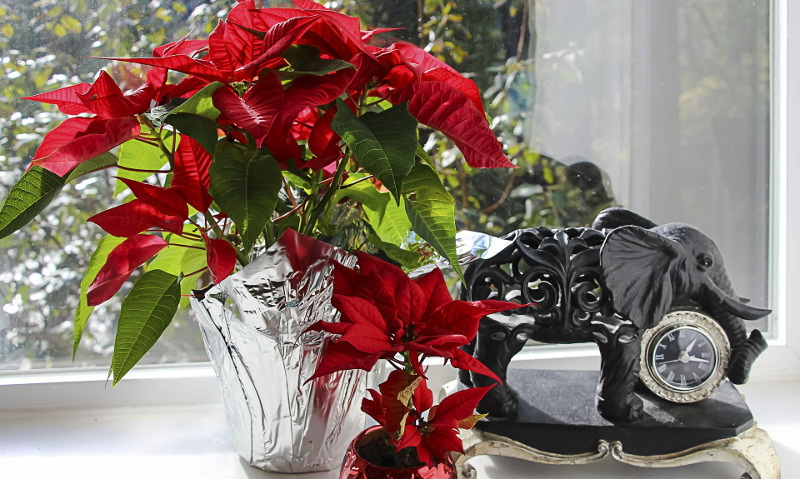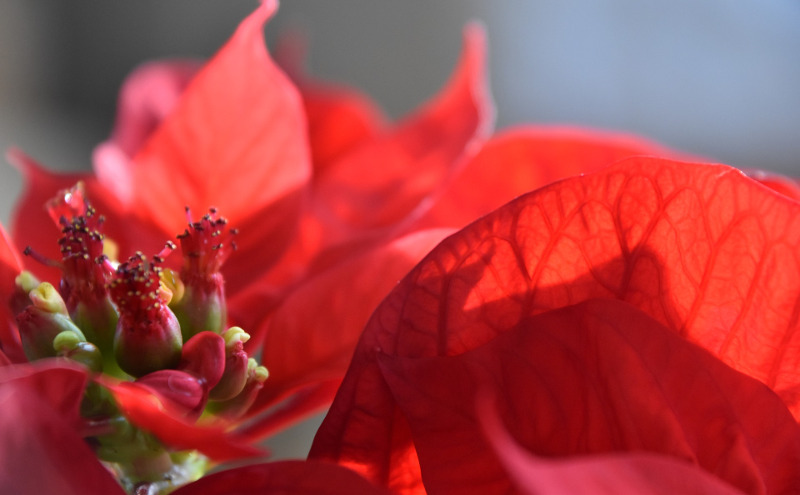Poinsettia (botanical name: Euphorbia pulcherrima) are a native plant of Mexico, where the plant is a flowering shrub that will grow 10-15 feet tall. The shrubs were once considered weeds in Mexico. Poinsettias are typically grown and sold as annuals, however you can grow poinsettias year after year. Caring for poinsettias is fairly easy but there are easy steps to take to ensure the plant at least looks beautiful through Christmas!

Caring For Poinsettias in December
To ensure the best health of your poinsettias, follow these simple steps from the time you bring the plant home until after Christmas.
1. Place the plant in a location that receives 6 hours of sunlight per day. It should just be light though, and not direct sunlight.
2. Ensure the plant is not near a heat register and drafty exterior doors and windows. The plants should be kept in an area between 65 and 70 degrees fahrenheit, and never below 55 degrees.
3. The plants prefer soil that is moist but not wet. This means that the container the plant comes in should have drainage holes to allow the water to drain through the soil. If the plant has foil at the bottom, you should remove that to allow the water to drain through.
4. Watering poinsettias should be done when the soil is dry. Check the top 1 to 2 inches of the soil to determine if water is needed. Use room temperature water. Discard any excess water from the saucer once the water drains through.
*Overwatering and underwatering the plant are the two most common mistakes people make when caring for the plant. Both of these will cause the plant to die, the leaves to wilt or the leaves to drop off the plant.
Care For Poinsettias After Christmas
Most people think the flowers of a poinsettia are the colored bracts in the center of the plant. However, the flowers are actually in the center of the colorful bracts.
Tip: For the longer-lasting poinsettias, purchase plants with the least amount or none of the yellow pollen showing.
Once the pollen shows in the plant, poinsettias will then drop the leaves soon after. After the leaves drop, the plant will need to go dormant and will require less water. Watering once per week should be enough. Be mindful of the soil to not overwater.
In March or April, cut back the branches 50%. When new growth appears, you can begin to water again like normal. Use regular houseplant fertilizer and food at this time too.
If you choose to, it is possible to move the plant outdoors when nightime temperatures are always above 55 degrees. You can either plant in the ground or into a new planter outdoors. The new planter should be larger than the container the poinsettia originally came in.
Whether you choose to keep the plant indoors or move it outside, the same care instructions should be followed as before. The plant will do best with strong morning direct sunlight and bright indirect light the rest of the day. So in the United States, the East side of the house is probably the best location for the plant.
In the summer months, you can pinch back the branches to encourage a bushier shrub.
Getting Poinsettias To Bloom Again
It can be difficult to get a poinsettia to bloom again. Once the temperature drops in the fall, bring the plant inside. From October 1st to December 1st (or for at least 40 days) the poinsettia will need to follow a strict light regimen in order to bloom again. The plant will need 13-16 hours of complete darkness each day, and 8 hours of bright indirect sunlight. There are several ways to accomplish this, but the two easiest ways are to place the plant in a dark closet, or cover up the entire plant with a cardboard box. It takes a lot of work, but if done correctly you should have a beautiful poinsettia in time for Christmas again!
Poinsettia Facts
- Poinsettias are the best selling potted plant in the United States and Canada, contributing to over $250 million to the U.S. economy according to the University of Illinois extension office.
- There are over 100 varieties of Poinsettias in all colors including traditional red, pink, white, yellow, purple & salmon.
- Over 70% of all poinsettias purchased in the United States are grown at Paul Ecke Ranch in California. They also grow around 50% of the world-wide poinsettias sold.
- December 12th is Poinsettia Day, which represents the death of Joel Roberts Poinsett in 1851. Poinsett was a botanist, physician and the first United States Ambassador to Mexico who introduced the plant to the United States.
- In Mexico and Guatemala, the poinsettia is now known as "La Flor de la Nochebuena" which means the Flower of the Holy Night, or Flower of Christmas Eve. In Chile and Peru, the poinsettia is known as the Crown of the Andes.
- In Spain, the flower takes on a different meaning. It is known there as “Flor de Pascua”, which means “Easter flower”.
- Other names the plant is referred to as, is the lobster flower and the flame-leaf flower.

Are Poinsettias Poisonous?
The plants are not poisonous to humans, however the sap produced by the plant can be irritating to the skin. And if the leaves or branches of the poinsettia are ingested, it could cause stomach discomfort. A study made by the Ohio State University found that a 50 pound child would have to eat over 500 leaves to have any harmful side effects. If pets eat the leaves, it can cause vomiting or diarrhea.
*If you experience any severe pain, seek medical help immediately.
 |
Author Chris Link - Published 11-23-2020 |
